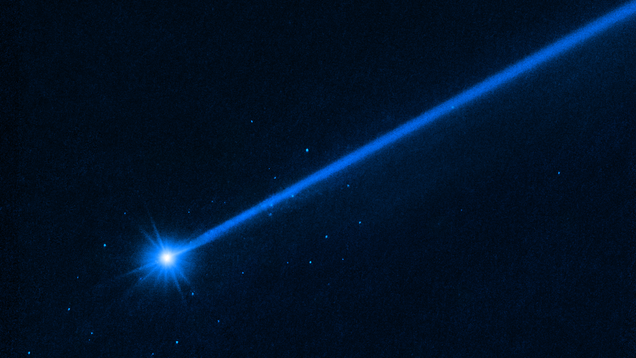Astronomers using the Hubble Space Telescope have detected nearly 40 boulders near Dimorphos—the target of NASA’s wildly successful DART experiment to deflect a non-threatening asteroid. This isn’t exactly positive news, since it suggests that hitting a bona fide hazardous asteroid might create a cluster of possibly dangerous boulders advancing towards Earth.
I’m inclined to frame this as a good news, bad news sort of thing. The good news is that the Hubble Space Telescope continues to be awesome, the bad news being the detection of 37 newly dislodged boulders floating in the vicinity of Dimorphos (to be crystal clear, these boulders do not pose a threat to Earth). In all fairness, this is largely positive news, as NASA’s pioneering DART (Double Asteroid Redirection Test) keeps producing crucial findings that only serve to enhance our understanding of planetary defence strategies against dangerous asteroids.
New research published today in The Astrophysical Journal Letters details the discovery of these objects. These boulders flew into the dark void as a result of the DART experiment, in which a 1,340-pound probe smashed into the non-threatening asteroid on September 26, 2022, at speeds reaching 22,530 kilometres per hour. As a result of the kinetic impact, Dimorphos now orbits Didymos—its larger partner—32 minutes faster than it did before. The binary pair is located at an average distance of 12 million kilometres from Earth, and as mentioned earlier, they don’t pose a threat to Earth—neither before or after DART.
As NASA’s test suggests, kinetic impactors might work when the real deal comes our way, but the presence of these new boulders presents a complication. As the Hubble press release points out: “This might mean that smacking an Earth-approaching asteroid might result in a cluster of threatening boulders heading in our direction.” Ouch.
Hubble data points to the presence of at least 37 free-flung boulders, ranging in size from 1 metre to 7 metres in diameter. From the perspective of planetary defence, that presents a bit of a problem. Asteroids as big as 7 metres across could disintegrate in the atmosphere, but they could also survive to impact the surface, depending on their composition, entry angle, and other factors. Importantly, an asteroid of this size would cause significant damage were it to strike near populated areas.
The boulders which are now travelling alongside Dimorphos are scattered unevenly across an area about 10,000 kilometres wide. Of the boulder batch, 15 are larger than 4 metres in diameter, according to the study. They appear to be moving away from Didymos at a slow pace, drifting away at roughly 804 metres per hour.
“This is a spectacular observation—much better than I expected,” David Jewitt, the first author of the study and a planetary scientist at the University of California-Los Angeles, explained in the press release. “We see a cloud of boulders carrying mass and energy away from the impact target.” For the first time, we’re seeing the result of an asteroid impact, which includes the ejection of large boulders, some of the dimmest objects ever observed in our solar system, he said, adding that it’s like a “very slowly expanding swarm of bees that eventually will spread along the binary pair’s orbit around the Sun.”
Dimorphos is likely a so-called “rubble pile” asteroid, meaning it’s not a solid piece of space rock but rather a loose collection of pebbles, dirt, and boulders. When DART struck this moonlet, the impact disturbed these boulders, which had been held in place by Dimorphos’s paltry gravitational pull, causing them to be launched into space. Interestingly, DART didn’t generate these boulders through the impact; it simply dislodged them. The scientists estimate that about 2% of the boulders on Dimorphos’s surface were displaced from a specific area, which is now, presumably, a crater approximately 160 feet in diameter.
This finding poses a new puzzle for astronomers: What was the precise mechanism through which DART’s collision dislodged this material? It might be part of the ejecta plume, or perhaps the result of seismic forces echoing through the small asteroid. Further examinations with the Hubble telescope could potentially shed new light on the matter.
Same for Hera—a probe that’s set to launch next year on a journey to the Didymos-Dimorphos system. Hera, a European Space Agency mission, will look for changes in Dimorphos’s orbital path, while also collecting data on both the surface and internal features of the disturbed moonlet. In the meantime, NASA’s Planetary Defense Coordination Office has some thinking to do about the efficacy and safety of kinetic impactors, while also considering future missions to learn more.
